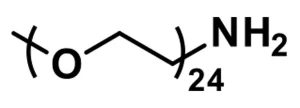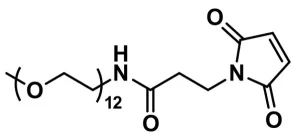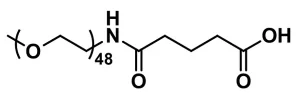m-dPEG®12-DBCO, product number QBD-10596, is a methoxy-terminated, discrete polyethylene glycol (dPEG®) click chemistry reagent designed for chemical modification of surfaces through strain-promoted azide-alkyne cycloaddition (SPAAC). From the terminal methyl group to the reactive site on the dibenzylcyclooctyne (DBCO) group, the dPEG® spacer is 39 atoms long.
DBCO was designed for bio-orthogonal click chemistry applications using SPAAC, also known as copper-free click chemistry, which was developed by Carolyn Bertozzi and colleagues to avoid the potential toxicity of Cu(I) that is used in Copper(I)-Promoted Azide Alkyne Cycloaddition (CuAAC) discovered by K. Barry Sharpless and colleagues. The dPEG® spacer differs from traditional PEG spacers and linkers in that it consists of a single molecular weight and chain length of PEG (i.e., it is monodispersed), which simplifies analysis of conjugates made with this compound.
Potential uses for this product include modifying alkyne-functionalized surfaces and peptides and proteins containing alkyne-functionalized amino acid side chains.
| Unit Size | 100mg, 1000mg |
|---|---|
| Molecular Weight | 861.03; single compound |
| Chemical formula | C₄₅H₆₈N₂O₁₄ |
| CAS | N/A |
| Purity | > 97% |
| Spacers | dPEG® Spacer is 39 atoms and 45.0 Å |
| Shipping | Ambient |
| Typical solubility properties (for additional information contact Customer Support) | Methylene Chloride, Acetonitrile, Methanol, DMSO, or DMAC. |
| Storage and handling | -20°C; Always let come to room temperature before opening; be careful to limit exposure to moisture and restore under an inert atmosphere; stock solutions can be prepared with dry solvent and kept for several days (freeze when not in use). dPEG® pegylation compounds are generally hygroscopic and should be treated as such. This will be less noticeable with liquids, but the solids will become tacky and difficult to manipulate, if care is not taken to minimize air exposure. |
Greg T. Hermanson, Bioconjugate Techniques, 2nd Edition, Elsevier Inc., Burlington, MA 01803, April, 2008 (ISBN-13: 978-0-12-370501-3; ISBN-10: 0-12-370501-0). Specifically see pp. 726-729 in his Chapter 18 on discrete PEG compounds for pegylation applications.
Greg T. Hermanson, Bioconjugate Techniques, 3rd Edition, Elsevier, Waltham, MA 02451, 2013, ISBN 978-0-12-382239-0; See chapter 18, Discrete PEG Reagents, pp.787-821, for a full overview of the dPEG® products.
Applicable patents and legal notices are available at legal notices.




Stay in the Loop. Join Our Online Community
Products
Ordering
About Us
Application
Resources

©Vector Laboratories, Inc. 2025 All Rights Reserved.
To provide the best experiences, we use technologies like cookies to store and/or access device information. Consenting to these technologies will allow us to process data such as browsing behavior or unique IDs on this site. Not consenting or withdrawing consent, may adversely affect certain features and functions. Privacy Statement
How do I Request a Quote?
To request a quote for products: